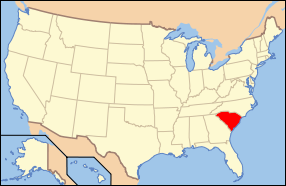South Carolina in the American Civil War
| State of South Carolina | |||||
|---|---|---|---|---|---|
| Nickname(s): "Palmetto Republic" | |||||
|
|||||
| Capital | Columbia | ||||
| Largest City | Charleston | ||||
| Admission to confederacy | February 4, 1861 (1st) | ||||
| Population |
|
||||
| Forces supplied |
|
||||
| Major garrisons/armories | Fort Sumter, Charleston Harbor | ||||
| Governor |
Francis Pickens (1860-1862) Milledge Bonham Andrew Magrath |
||||
| Senators |
Robert Woodward Barnwell James Lawrence Orr |
||||
| Representatives | List | ||||
| Restored to the Union | July 9, 1868 | ||||
South Carolina was the first state to secede from the Union (Dec. 1860), and was one of the founder members of the Confederacy (Feb. 1861). The bombardment of the beleaguered U.S. garrison at Fort Sumter in Charleston harbour on April 12th 1861 is normally reckoned as the first military engagement of the war.
South Carolina was a source of troops for the Confederate army, and as the war progressed, also for the Union, as thousands of ex-slaves flocked to join the Union forces. The state also provided uniforms, textiles, food, and war material, as well as trained soldiers and leaders from The Citadel and other military schools. In contrast to most other Confederate states, South Carolina had a well-developed rail network linking all of its major cities without a break of gauge. Relatively free from Union occupation until the very end of the war, South Carolina hosted a number of prisoner of war camps. South Carolina also was the only Confederate state not to harbor pockets of anti-secessionist fervor strong enough to send large amounts of white men to fight for the Union, as every other state in the Confederacy did.
Among the leading generals from the Palmetto State were Wade Hampton III, one of the Confederacy's leading cavalrymen, Maxcy Gregg, killed in action at Fredericksburg, Joseph B. Kershaw, whose South Carolina infantry brigade saw some of the hardest fighting of the Army of Northern Virginia and James Longstreet who served in that army under Robert E. Lee and in the Army of Tennessee under Gen. Braxton Bragg.
The white population of the state had strongly supported the institution of slavery since the 18th century. Political leaders such as Democrats John Calhoun and Preston Brooks had inflamed regional and national passions in support of the institution, and many pro-slavery voices had cried for secession. On the outbreak of war, South Carolina, had the highest percentage of slaves of any U.S. state at 57% of its population enslaved and 46% of its families owning at least one slave.
...
Wikipedia



